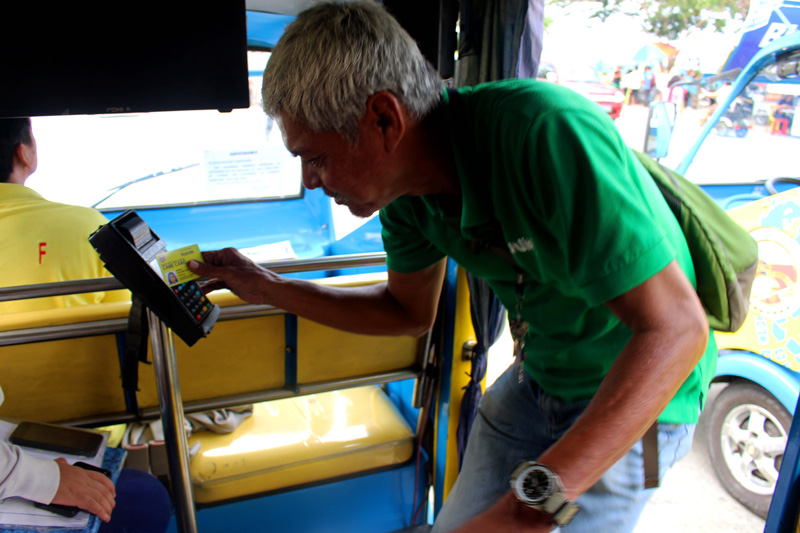
Photo: Drivers
How the Philippines is using smart cards to transform access to mobility
11 December 2017
by Jonathan Andrews
Nick Michell looks at how an innovative initiative by the city of Muntinlupa in the Philippines is not only providing public transport to areas that were previously deprived, but also using clean, electric vehicles to do so
Much like the yellow taxi in New York or the red double-decker bus in London, the vibrantly coloured Jeepney is an iconic presence on the gridlocked streets of Manila and much of the rest of the Philippines. However, these shared minibuses, the most popular means of public transport in the country, could be on the way to being phased out in favour of more environmentally-friendly vehicles.
The Philippines transport department is working on a modernisation strategy that is expected to replace all diesel-fuelled Jeepneys over 15 years old with electric models by 2020, contributing significantly to reducing the country’s carbon emissions. While the potential loss of these famous vehicles is a contentious issue in many cities, a certain group of commuters in the city of Muntinlupa are already benefitting from the introduction of a set of electric Jeepneys, or ‘e-Jeepneys’.
In 2015, the city government of Muntinlupa and Lingkod Muntinlupa Foundation, a non-profit community organisation, launched a project called ‘Leading the e-Jeepney revolution in the Philippines’, which introduced 14 e-Jeepneys into areas that previously lacked adequate public transport, providing free rides to students, persons with disabilities and the elderly.
“The routes in the city were thoroughly studied and it was concluded that in some areas, illegal tricycles were the only mode of transport available, people had to cross several footbridges to get to their destination and there was even no route that directly passed by the city’s government hospital,” says Grace Salvador, Programme Director, Lingkod Muntinlupa Foundation, which serves the needs of local people through connecting private philanthropy with city government social service programmes. “The people who benefit from the new routes are mostly patients of the public hospital and the elderly who had a hard time walking across the footbridges.”
The e-Jeepneys will utilise the Muntinlupa Care Card (MCC), the most advanced electronic smart card system in the Philippines, for payment. Citizens that sign up for the Muntinlupa Care Card annual membership, at a cost of 80 pesos or US$1.60, can use the smart card both on-board e-Jeepneys and for a number of other public services. The MCC is the first and only city government benefit card in the Philippines that uses smart technology to collect and use the data of its constituents to provide a more efficient delivery of services.

One of the key elements to the Muntinlupa Care Card and e-Jeepney initiative is the priority given to senior citizens and persons with disabilities, supplementing several programmes already in place from the city government. The e-Jeepneys provide free rides to student MCC cardholders who attend public schools that are either remote or where classes begin as early as 5.30am. The students are the first riders in early morning and do not usually coincide with the travel time of other cardholders.
“These sections of the society [students, senior citizens and persons with disabilities] are completely dependent on public transport,” says Jaspal Singh, Head of UITP’s India Office. “In many rural areas, young girls cannot go to school as there are no modes of transport available. Senior citizens require both safe and convenient transport and its absence means that a large proportion of the elderly cannot access better medical facilities or recreational activities. Similarly, persons with a disability are deprived of economic opportunities due to fewer means of travel. Society should give greater consideration to the most vulnerable and provide cheaper or free travel. However, government should bear the expenditure for this rather than operators.”
The traditional Jeepneys, originally made from US military jeeps left over from World War II, often use cheap diesel and emit plumes of smoke as they noisily navigate city streets, packing their benches full of passengers, who bump their heads on the ceiling and cling to the roof while standing on a tiny step at the back. While these time-honoured vehicles are still held in great affection by those that have grown up riding them, they are heavy polluters. The new e-Jeepneys, however, will significantly reduce both noise and air pollution. The e-Jeepneys are powered by deep-cycle lead-acid batteries and use an electric motor instead of an internal combustion engine, which produces zero smoke and noise emissions. Add to this the latest electronic smart card platform, an organised fleet management structure and charging technology, and you have new vehicles with advantages that far outweigh the old versions.
While the advantages of the new e-Jeepneys are clear, owners and drivers of the traditional models are not only concerned about losing the vehicles they have driven for years and are attached to, but also scared for their livelihoods, as they are often the sole financial support for whole families.
“Initially in Muntinlupa there was resistance from the drivers of regular Jeepneys,” adds Salvador. “This was later resolved though through open communication with drivers and operators, explaining that the free rides were limited to members only and that the e-Jeepneys were not competing with them as they were servicing other routes that were previously deprived of good public transport.”
The Philippine government has admitted that the phasing out of the old Jeepneys and the transition to more environmentally-friendly models will be a challenge, particularly with regard to ensuring that the owners, drivers and industry as a whole are not negatively affected. Authorities have vowed to help owners sell old Jeepneys and access loans to buy the new models, while also providing drivers with training.
The drivers of the new e-Jeepneys in Muntinlupa have all received technical and safety training, while being instilled with the values of courteousness, discipline and responsibility for their passengers, other motorists and pedestrians. The new vehicles also possess flat screen televisions with surround sound, which are intended to be used as a paid advertising platform, but in the infancy of the programme are being utilised to promote local city government services.
Since its launch in 2015, US$270,000 has been invested into the e-Jeepney initiative, with financing coming from new membership and renewal fees of the Muntinlupa Care Card programme. In the next two years, membership is expected to reach 300,000, up from 130,000 at present. The city government has ordered an additional six electric Jeepneys to be delivered this year, while also undertaking further research into other electric vehicles, such as e-tricycles.

“As the leader in using electric Jeepneys in the country, we believe that our model can be replicated in other cities in the Philippines,” explains Salvador. “We have set an example that the riding public can accept alternative modes of transport and embrace new ways of riding. Our operations are only currently on a small scale, but it is still a big leap towards finding a more sustainable transport solution that would have a long-term impact on our environment.”
Muntinlupa’s successful e-Jeepney initiative has already gained recognition this year, when it was announced as one of the winners of the UITP Awards, under the ‘Customer Experience’ category. The awards celebrate the most innovative and ambitious sustainable mobility projects from across the world, contributing to the sector objective of doubling the market share of public transport by 2025.
The jury said the award was given due to the project’s creative redefinition of customer experience for a flexible public transport service that is a core feature of mobility in the Philippines, and the e-Jeepneys’ use of new technology to enable booking and payment based on a customer-centred approach to service design. The success of the project has set an example and is providing inspiration for other Asian countries to follow in Muntinlupa’s footsteps.
“It is very important to provide low-cost public transport, as large numbers of people cannot afford transport facilities in developing countries, particularly in rural areas,” says Singh. “Mobility is also important for the economic development of cities. Lots of people cannot fully utilise their skills due to expensive or lack of public transport. In India, the government is promoting e-rickshaw and mini-vans to create employment opportunities, as well as bridge the skill gap. Some cities are now promoting bike taxis in India too as a low cost alternative.”








